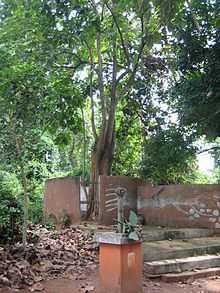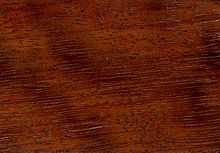Iroko

Iroko is a large hardwood tree from the west coast of tropical Africa. It is one of the woods sometimes referred to as African Teak, although it is unrelated to the teak family. The wood colour is initially yellow but darkens to a richer brown over time. It is yielded mostly (probably) by Milicia excelsa. In much of the literature on this timber the names of the trees that yields it are given as Chlorophora excelsa and Chlorophora regia.[1][2] The tree is feared in some cultures where it originates and hence is shunned or revered with offerings.[3] Yoruba people believe that the tree is inhabited by a spirit, and anybody who sees the Iroko-man face to face becomes insane and speedily dies.[4] According to the Yoruba, any man who cuts down any Iroko tree causes devastating misfortune on himself and all of his family.[4] They also claim that the spirit of the Iroko can be heard in houses which use Iroko wood, as the spirit of the Iroko is trapped in the wood.[4] In Nigeria similar claims are made about other trees.
Uses

The wood is used for a variety of purposes including boat-building, domestic flooring and furniture. From the late 1990s, it was used as part of the txalaparta, a Basque musical instrument constructed of wooden boards, due to its lively sound. Iroko is one of the traditional djembe woods.
It is a very durable wood; iroko does not require regular treatment with oil or varnish when used outdoors. Although it is almost as durable as teak, it does not have the same stability.
In the UK there are no trade restrictions on the machining of this timber. The only reported adverse effects known to be caused by the dust from Iroko are asthma, dermatitis and nettle rash.[5]
References
- ↑ iroko wood, Encyclopædia Britannica on-line
- ↑ Chlorophora excelsa (Welw.) Benth., Taxonomic Serial No.: 506548, Integrated Taxonomic Information System
- ↑ Twilight Tales3. CUP Archive. p. 26. Retrieved 2 April 2011.
- ↑ 4.0 4.1 4.2 Ogumefu, M. I. (1929). Yoruba legends. Forgotten Books. p. 10. ISBN 978-1-60506-017-0. Retrieved 2 April 2011.
- ↑ "HSE Toxic Woods Information Sheet". Health and Safety Executive.